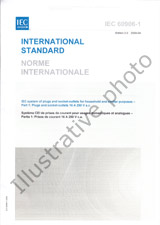We need your consent to use the individual data so that you can see information about your interests, among other things. Click "OK" to give your consent.

IEC/IEEE 62704-2-ed.1.0
Determining the peak spatial-average specific absorption rate (SAR) in the human body from wireless communications devices, 30 MHz to 6 GHz - Part 2: Specific requirements for finite difference time domain (FDTD) modelling of exposure from vehicle mounted antennas
Translate name
STANDARD published on 28.6.2017
The information about the standard:
Designation standards: IEC/IEEE 62704-2-ed.1.0
Publication date standards: 28.6.2017
SKU: NS-686674
The number of pages: 108
Approximate weight : 355 g (0.78 lbs)
Country: International technical standard
Category: Technical standards IEC
The category - similar standards:
Annotation of standard text IEC/IEEE 62704-2-ed.1.0 :
IEC/IEEE 62704-2:2017 establishes the concepts, techniques, validation procedures, uncertainties and limitations of the finite difference time domain technique (FDTD) when used for determining the peak spatial-average and whole-body average specific absorption rate (SAR) in a standardized human anatomical model exposed to the electromagnetic field emitted by vehicle mounted antennas in the frequency range from 30 MHz to 1 GHz, which covers typical high power mobile radio products and applications. This document specifies and provides the test vehicle, human body models and the general benchmark data for those models. It defines antenna locations, operating configurations, exposure conditions, and positions that are typical of persons exposed to the fields generated by vehicle mounted antennas. The extended frequency range up to 6 GHz will be considered in future revisions of this document. This document does not recommend specific peak spatial-average and whole-body average SAR limits since these are found in other documents, e.g. IEEE C95.1-2005, ICNIRP (1998). Key words: Electromagnetic Field, Finite-Difference Time Domain (FDTD), Spatial-Average Specific Absorption Rate (SAR), vehicle mounted antennas IEC/IEEE 62704-2:2017 definit les concepts, les techniques, les procedures de validation, les incertitudes et les limitations de la technique des differences finies dans le domaine temporel (FDTD) appliques pour determiner le debit d’absorption specifique (DAS) maximal moyenne et le debit d’absorption specifique global moyen. Cette determination est realisee au moyen dun modele normalise de corps humain, expose au champ electromagnetique emis par des antennes sur vehicule, dans la plage de frequences de 30 MHz a 1 GHz, qui concerne les produits et les applications typiques de radio mobile haute puissance. La presente partie de lIEC/IEEE 62704 definit et fournit les donnees relatives aux vehicules d’essai, aux modeles de corps humains et les donnees generales de reference pour ces modeles. Elle definit les emplacements des antennes, les configurations de fonctionnement, les conditions d’exposition et les positions typiques des personnes exposees aux champs generes par des antennes sur vehicule. La plage de frequences etendue jusqu’a 6 GHz sera prise en compte dans les futures revisions du present document. Le present document ne recommande pas de limites specifiques de DAS maximal moyenne et de DAS global moyen, celles-ci etant disponibles dans d’autres documents, par exemple, l’IEEE C95.1-2005, ICNIRP (1998). Mots cles: champ electromagnetique, technique des differences finies dans le domaine temporel (FDTD), maximal moyenne, debit d’absorption specifique (DAS), antennes sur vehicule
These changes apply to this standard:
Amendment 1 - Determining the peak spatial-average specific absorption rate (SAR) in the human body from wireless communications devices, 30 MHz to 6 GHz – Part 2: Specific requirements for finite difference time domain (FDTD) modelling of exposure from vehicle mounted antennas
Change published on 15.9.2025
Selected format:Show all technical information.
We recommend:
Technical standards updating
Do you want to make sure you use only the valid technical standards?
We can offer you a solution which will provide you a monthly overview concerning the updating of standards which you use.
Would you like to know more? Look at this page.



 Cookies
Cookies
